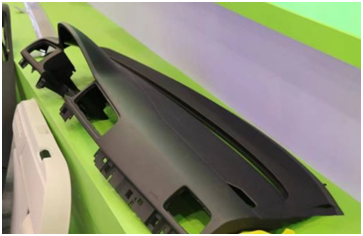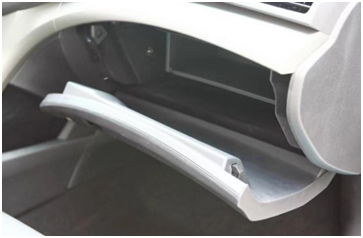©Copyright 2019 SIKO POLYMERS (SUZHOU) CO., LTD All rights reserved.Site Map Powered by iwonder.cn
- Email Uskevin@sikopolymers.com


Ⅰ. Polypropylene material in the application of automotive interior
Polypropylene can be modified by toughening, filling, strengthening, blending and other methods to obtain different properties of the material, in the car
The modified polypropylene material has been widely used in decoration.
1, The dashboard
The instrument panel that uses at present can divide for horniness instrument panel and half horniness instrument panel.
Middle - and high-grade cars use semi-rigid instrument panels. As semi-rigid instrument panel skeleton and air duct materials, different models, different designs can have a lot of materials to choose from, long glass fiber 20% reinforced polypropylene PPLGF20 due to its good rigidity should be a very good choice.
Mid - and low-grade cars mostly use hard instrument panels. Rigid instrument panel is composed of two parts, can be divided into instrument panel upper body, instrument panel lower body and skeleton three parts. Because PP/EPDM-T20 has good toughness and certain rigidity, it becomes the first choice of upper and lower body materials for instrument panel. Of course, the upper body material of the dashboard can also be used PP/ EPDM. T10 or PP/EPDM-T15. PP. T20 or PP. T30 is usually available as the skeleton material.

2, Glove box
The outer plate of the glove box can also be made of PP/ EPDM.T20, and the inner plate can be made of PP-T20 or PP-T30.

3, The DOOR TRIM
The DOOR TRIM materials can be PP/ EPDM. T10, PP/ EPDM. T15, PP/EPDM-T20.

4, Deputy dashboard
The options are PP/ EPDM. T15 or PP/EPDM-T20.

5, The column guard
A/B/C column guard can choose A lot of PP materials, such as PP-T20, PP/ EPDM. T20 or PP, PE and so on.

6, The seat plate
PP/ EPDM. T20 or PP/PE

7, Package frame guard plate
Due to the package frame to bear, the skeleton material must have a certain rigidity, so the base material can choose PPGMT40 or PPGMT30.

The above only talked about the application of polypropylene material in some typical parts of automotive interior, and there are many other polypropylene materials used in interior parts, such as PP-GF20 or PP-GF30 and so on. The typical applications mentioned above are only examples, but other kinds of polypropylene materials can also be used.
Ⅱ. PP material requirements for interior parts
Polypropylene has been modified to obtain completely different materials to meet the performance requirements of various components. As the car gradually into People's Daily life, it and people's contact is closer and closer, more and more, whether from the vision, touch or smell, people have higher and higher requirements. In order to create a more comfortable and beautiful automotive interior environment, this paper puts forward some other requirements for PP as interior material.
1, Requirements for scratch resistance
The raw material PP of automobile interior decoration parts is relatively low in hardness, so in the user's use process, some parts are easy to be scratched, scraped or kicked, for a long time, the surface of parts is obviously white, very ugly. Therefore, PP materials must have scratch resistance.
Specific requirements:
Under a certain load, with the specified knife, the surface of the sample vertical cross 20 lines, and then evaluate the brightness change of the scratched position. Usually the brightness variation is not more than 1.5, i.e. △L≤ 1.5. The commonly used loads are 5N and 10N, which can be selected according to the parts used or whether the paint is painted.
2, White mark resistance
PP material decorative parts in the assembly or by bending, impact and other external forces, often appear white phenomenon, and with the passage of time, white marks will be further expanded, affecting the beauty of the interior. This is commonly known as stress whitening. In order to avoid stress whitening, PP materials must also have resistance to stress whitening.
Specific requirements:
At a certain height, the sample was subjected to a falling ball impact test, and then its brightness change was evaluated and recorded. After a period of time, the brightness change of the impacted part was evaluated again. Then the sample was stored at high temperature and the brightness change of the sample was re-evaluated after a specified time.
3, Heat aging property
Due to its own structure, polypropylene material is easy to be oxidized by oxygen in the air, especially by the action of light and heat, will accelerate aging, and then destroy its physical and mechanical properties. It affects the service life of the parts. Therefore, PP materials must have heat resistance to oxygen aging properties. As interior parts, at least 400 hours should meet the conditions of 150℃ without powder phenomenon. Experiments can be done with whole parts, or parts can be cut into splines and carried out in a drying box.
4, Send out the performance
The air quality requirement of automobile interior is higher and higher, and the country will soon introduce the air quality requirement of automobile interior and other related standards. Therefore, in order to ensure a good automotive interior environment, as interior parts, must meet the four requirements of emission performance without exception. The emission performance of interior decoration includes odor test, formaldehyde content determination, condensation composition, total carbon emission.
Specific requirements:
Odor score ≤3 Formaldehyde content ≤10mg/Kg
Condensing composition ≤2mg Total carbon content ≤50μgC/g
Interior PP materials must also meet the above requirements.
5, Light aging resistance requirements
Open the door, for the user can directly see the parts, it can be directly or indirectly exposed to sunlight. In order to avoid the discoloration and deformation caused by sunlight, the raw material itself must have the performance of light aging resistance.
Specific requirements:
First of all, according to the specific use of parts to determine the degree of exposure to sunlight, that is to say, is directly exposed to sunlight or indirect exposure to sunlight, and then determine the exposure cycle. Under certain irradiation intensity (uV), temperature, humidity and other conditions, after a certain exposure period, it is required that the color fastness of the sample does not change more than 4(evaluated by gray scale), or △E≤ 1.7.
6, Stickiness resistance
With the wide application of PP material in automotive interiors, new problems have been exposed. In atmospheric exposure, precipitates are produced on the surface of polypropylene parts, and sticky phenomenon occurs at the same time, and the luster of the surface of parts has also changed.
For this purpose, PP materials must have anti - sticky properties. Simple thermal aging, sunlight simulation and the usual experimental conditions of interior light aging can not reproduce the sticky phenomenon, must be in a more appropriate light aging conditions can be verified.
7, Good antistatic performance
We can observe that after the use of the car for a period of time, some parts of the surface tend to absorb dust, dust for a long time not only did not remove, and more and more dirty, it is difficult to clean, this is caused by static electricity. PP material due to the non-polar polymer, has good electrical insulation, and is not affected by humidity, so it is easy to generate static electricity. Over time, the above problems will occur. Severe static electricity can also produce shocks and even sparks.
Therefore, PP materials should also have antistatic properties. Antistatic property can be measured by surface resistance and other indicators.
Conclusion:
PP materials are widely used in automotive interiors. It can be seen that it is difficult for materials to meet some requirements of interior parts. There are technical problems and cost reasons. Of course, not all interior parts should meet the above requirements at the same time, or combined with the function of specific parts and their use environment, to put forward suitable performance requirements of PP materials.
In the future, with the wide application of PP materials, there will be many problems. In order to meet the higher and higher requirements of automobile users, full attention must be paid to these problems. Only in this way, polypropylene materials will have a broader application prospect.